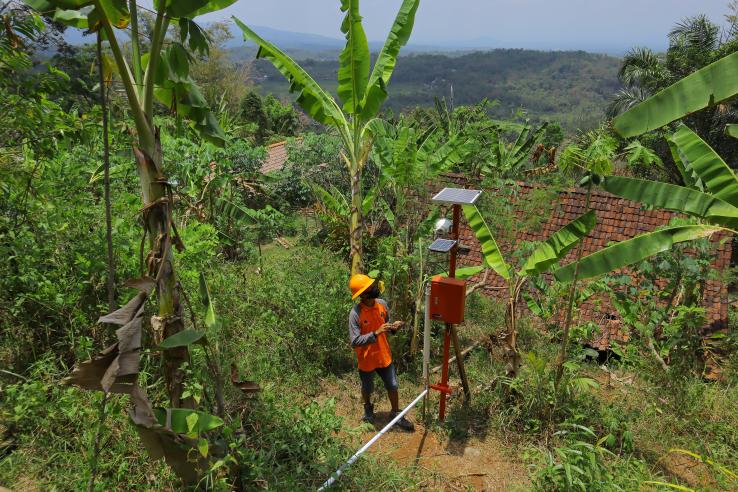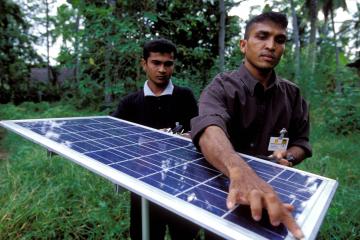
Of satellites and surveys: How innovative data collection can speed up climate action

We find ourselves in a make-or-break decade if we are to meaningfully confront the impacts of climate change on societies and ecosystems. The recently published Sixth Assessment Report by the Intergovernmental Panel on Climate Change (IPCC) leaves no doubt that the impacts of climate change are already felt today and will intensify in the future, affecting low- and middle-income countries most severely. The IPCC highlights that climate change acutely affects development outcomes, suggesting a “rapidly closing window of opportunity to secure a livable and sustainable future for all.” Not only does the world need to hit fast-forward on climate change mitigation by reducing greenhouse gas emissions, it also needs to ensure that those who are (and those who will be) feeling the impacts of climate change can adapt accordingly and sustain their livelihoods.
With increasing urgency to adapt to and mitigate climate change, it may be tempting to deploy innovations before they are rigorously evaluated in the field, in the name of reacting quickly. But innovations do not always achieve their intended impacts in the field, and there are large gaps between the engineering estimates and real-world performance of new technologies. Governments as well as companies concerned by climate change have much to gain from measuring the impact of existing solutions. Ultimately, we can save time by spending funds on the solutions that have been demonstrated to be effective, rather than putting resources into measures that will not achieve their desired results. Given limited time and resources, it is imperative to direct investments toward climate adaptation measures that work outside the lab, in the real world.
We should seize rapid climate action as an opportunity to carry out impact evaluations of policies, technologies, and programs through robust data collection and monitoring. Fortunately, large-scale, accurate data collection approaches are here to help and have become increasingly accessible to researchers and implementers in recent years. From administrative data (collected by governments or organizations) to satellite imagery and remote-sensing technology to forecast extreme weather events, randomized evaluations are beginning to leverage non-traditional data sources to yield timely and accurate results that can facilitate adaptation. To speed up the path from research to policy action, J-PAL’s King Climate Action Initiative (K-CAI) prioritizes funding research and scaling that uses administrative and remote sensing data to generate results in a timely manner.
The new kid on the block: Real-time data collection and non-traditional data sources
Traditionally, randomized evaluations have heavily relied on data sources like census and household survey data. Data collection can thus be costly and time-consuming. However, new approaches, like collecting data in real-time and in larger volumes, can unlock new kinds of interventions and generate results in a timely manner.
Data collected in real-time includes, for example, data from pollution sensors, air quality monitors, and satellite data. The ability to collect data in real-time unlocks insights into the short-, medium-, and long-run impacts of climate innovations, and allows for speedy optimization of interventions. This stands in contrast to surveys conducted after an intervention that captures effects, self-reported or otherwise, retrospectively rather than simultaneously—which delays informed climate action. In addition, real-time data can inform predictions about the future, such as accurate weather forecasts and early-warning systems, that can help communities adapt by preparing for impending weather shocks.
Randomized evaluations are already using properties of real-time data collection to unlock, for instance, new kinds of information interventions. In a study funded by K-CAI, researchers Douglas Almond (Columbia University) and Shuang Zhang (Imperial College London) are currently conducting an intervention across thirteen Chinese provinces, obtaining firms’ emissions data on a real-time basis. The real-time database started in January 2019 and continued to update on an hourly basis until 2022. Researchers collected hourly concentration data for three different air pollutants and three different water pollutants for every firm. Using this granular data, researchers identified firms with emissions above the regulatory limit, or suspicious data patterns that may point to intentional data manipulation. Leveraging this data is increasingly feasible in real-time and could provide objective information and thereby increase the effectiveness of environmental inspections.
Data collected in real-time, rather than after the fact, may also provide a unique opportunity for immediate feedback and incentives for changes in environmentally damaging behavior. In another ongoing K-CAI-funded study, J-PAL affiliated professor Robert Metcalfe (University of Southern California) is piloting techniques to reduce greenhouse gas emissions in the shipping industry by providing captains of cargo vessels with daily vessel data—offering personalized feedback, targets, and fuel-saving incentives via a software system. Feedback focuses on discrete captain behaviors, such as power management of engines, speed reduction, and route optimization.
These insights into the effectiveness of programs and policies are needed to combat climate change, as with every increment of global warming, climate impacts become more pronounced and challenging to adapt to.
Providing support where it is needed the most
Non-traditional data sources can help identify communities that are particularly vulnerable to the impacts of climate change. This information can help policymakers target adaptation interventions to these communities and ensure that they receive the support they need. Effective data processing approaches, such as classification through machine learning algorithms, can improve targeting adaptation support for the most vulnerable households and communities. For example, a study led by J-PAL affiliated professor and K-CAI co-chair Kelsey Jack (University of California Santa Barbara) on effective targeting of electricity subsidies in Cape Town is exploring whether administrative data can be used to better target subsidies to households with the greatest need for support. Better targeting of these subsidies could help the City of Cape Town achieve both its climate and its poverty alleviation goals.
In another study in Bangladesh, researchers Munshi Sulaiman (BRAC University), Ashley Pople (Oxford), J-PAL affiliate Stefan Dercon (Oxford), Rohini Kamal (BRAC University), and Rocco Zizzamia (Oxford) are evaluating an early action program to protect low-income communities from floods. The team is testing the efficacy of early flood alerts and adaptation assistance, and using satellite data to target these interventions to the most vulnerable households.
In identifying areas vulnerable to climate change, combining household surveys and satellite data may also provide insights into both climate phenomena, like changing weather patterns, as well as on-the-ground adaptation responses. This can allow us to identify informational and behavioral constraints to effective climate change adaptation. For example, J-PAL affiliated researcher Rohini Pande (Yale University) and Maulik Jagnani (University of Colorado Denver), utilize satellite data in an evaluation of an early warning flood forecasting system in Bihar, India. The study pairs cutting-edge forecasting and an Android-based flood alert system with grassroots volunteers trained in community outreach. Researchers subsequently employ household surveys to assess the system’s effectiveness in helping households adapt to flooding events. Early warning systems are one way in which satellite data can be leveraged to evaluate adaptation mechanisms as ex-ante information may facilitate precautionary measures.
The way forward: Setting up robust data collection systems
In the quest for timely climate mitigation and adaptation, rigorous evaluation may ultimately help us move faster by ensuring the real-world efficacy of public and private sector innovations. Using tools from computer science, data science, and engineering can unlock new opportunities for real-world evaluation of climate innovations and, potentially, protect livelihoods around the world. It is tempting to rely on intuition and good intentions to guide our actions, but there is no substitute for high-quality data. We need randomized evaluations and robust data collection and monitoring systems when rolling out new climate policies and programs to improve programs over time, across changing contexts, and ensure their effectiveness. Through rigorous evaluation, we can learn as we take action. Real-time data collection and monitoring, coupled with innovative approaches to data analysis, can help us identify vulnerable communities, target interventions effectively, and optimize our efforts to mitigate and adapt to a changing climate. Rigorous monitoring and evaluation, in turn, allow for more informed policy and private sector decisions during the current “window of opportunity” to drive a positive impact on the planet and the people who will most be affected by climate change.

